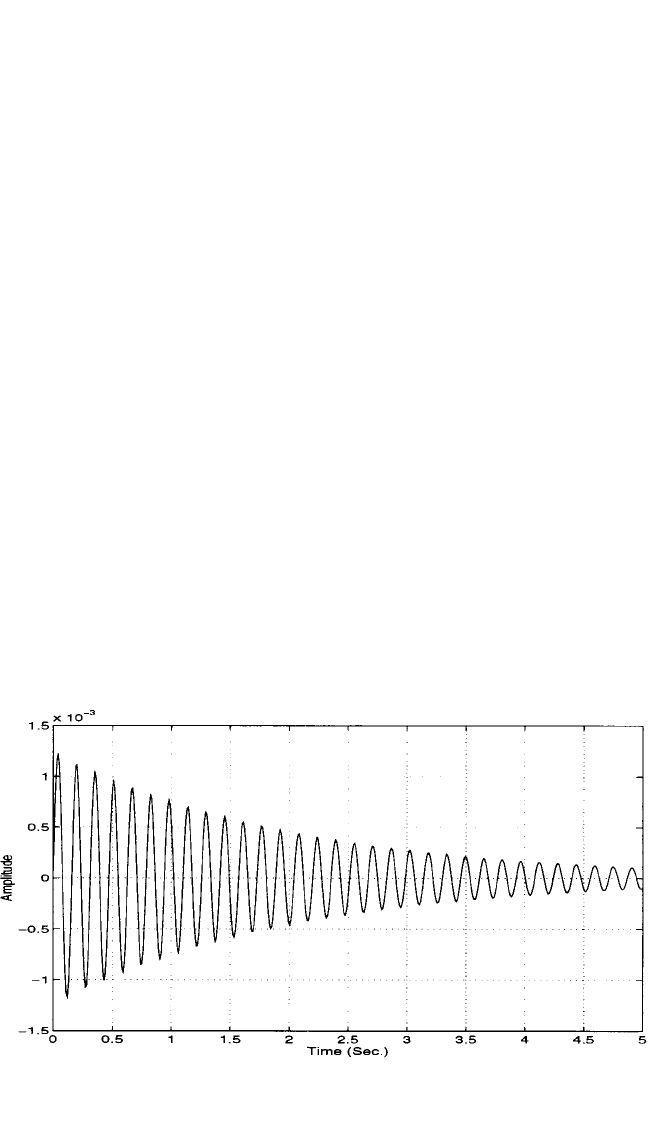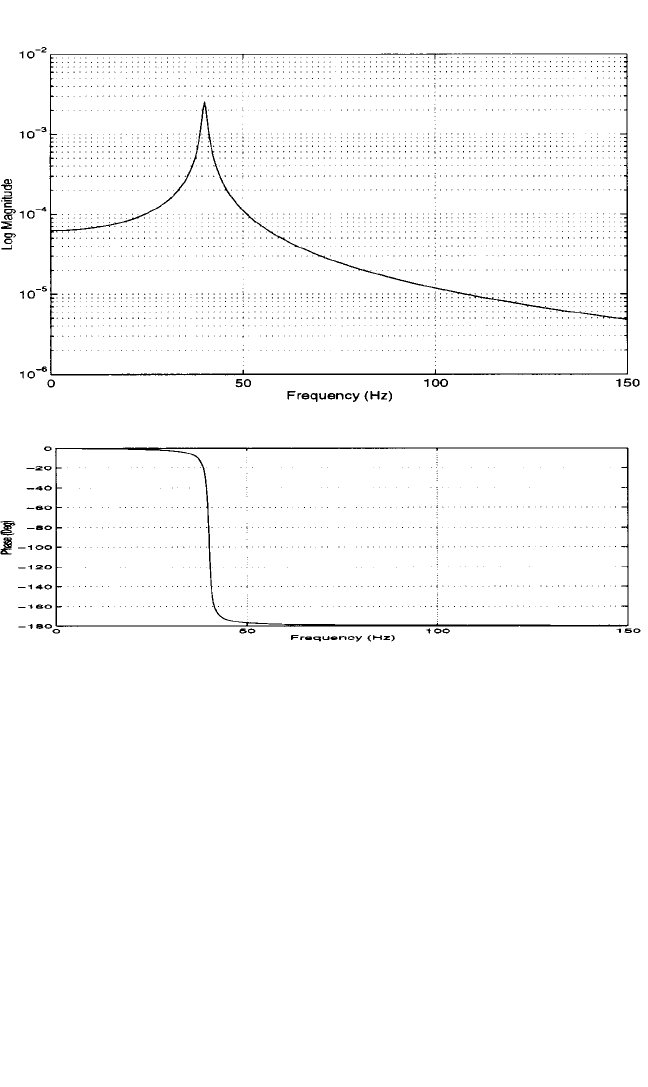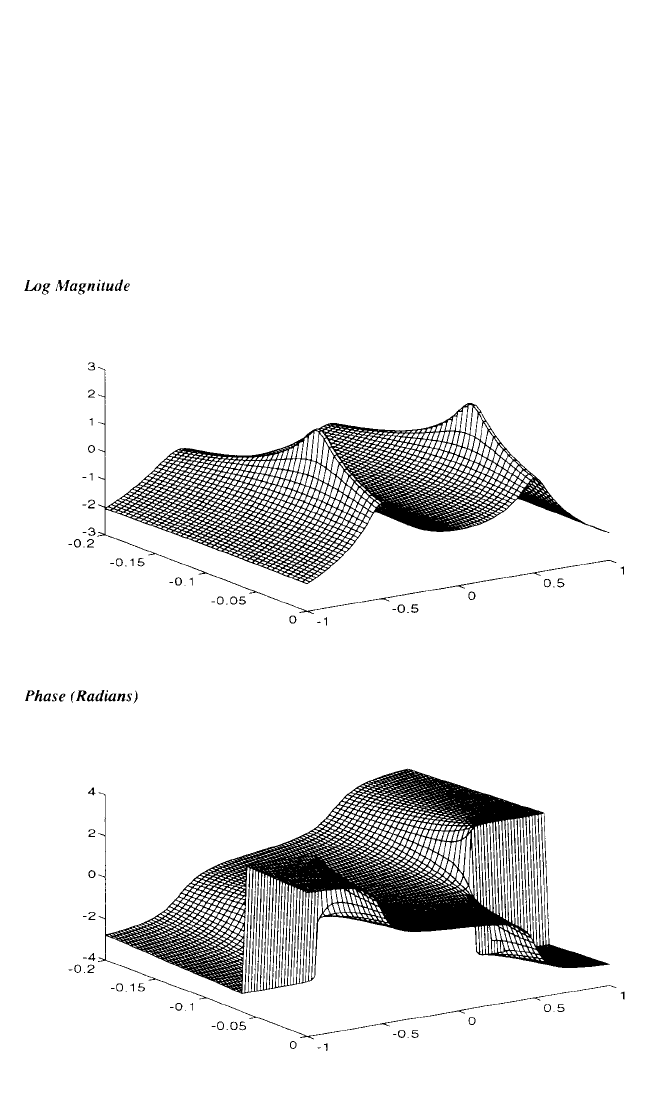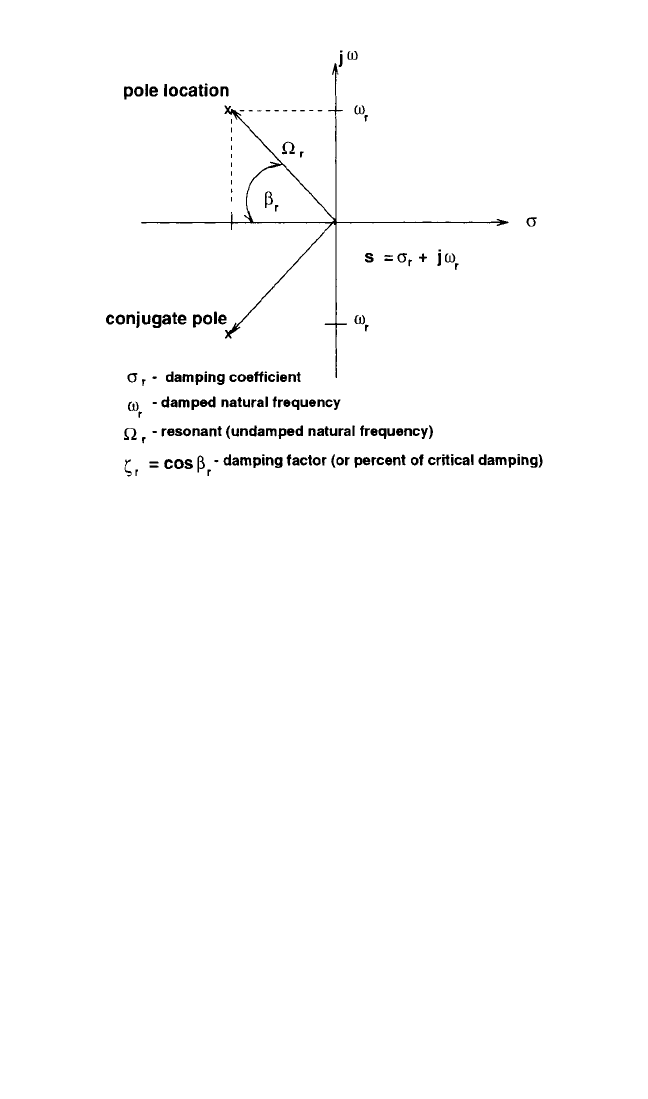Harris C.M., Piersol A.G. Harris Shock and vibration handbook
Подождите немного. Документ загружается.


where σ
1
= damping factor
ω
1
= damped natural frequency
The roots of the characteristic equation (21.2) can also be written as
λ
1
=−ζ
1
Ω
1
± jΩ
1
1
−
ζ
1
2
(21.6)
The damping factor is defined as the real part of a root of the characteristic equa-
tion.The damping factor describes the exponential decay or growth of the harmonic.
This parameter has the same units as the imaginary part of the root of the charac-
teristic equation, typically radians per second.
Time Domain: Impulse-Response Function. The impulse-response function of
the single degree-of-freedom system is defined as the time response x(t) of the sys-
tem, assuming that the initial conditions are zero and that the system excitation f(t)
is a unit impulse. The response of the system x(t) to such a unit impulse is known as
the impulse-response function h(t) of the system. Therefore
h(t) = Ae
λ
1
t
+ A
*
e
λ
1
*
t
= e
σ
1
t
[ Ae
+jω
1
t
+ A
*
e
−jω
1
t
] (21.7)
Thus, the residue A controls the amplitude of the impulse response, the real part of
the pole is the decay rate, and the imaginary part of the pole is the frequency of oscil-
lation. Figure 21.2 illustrates the impulse-response function for a single degree-of-
freedom system.
Frequency Domain: Frequency Response Function. An equivalent equation
of motion for Eq. (21.1) is determined for the Fourier or frequency (ω) domain.This
representation has the advantage of converting a differential equation to an alge-
braic equation. This is accomplished by taking the Fourier transform of Eq. (21.1).
Thus, Eq. (21.1) becomes
EXPERIMENTAL MODAL ANALYSIS 21.7
FIGURE 21.2 Single degree-of-freedom impulse-response function.
8434_Harris_21_b.qxd 09/20/2001 12:08 PM Page 21.7

[ −mω
2
+ jcω+k ] X(ω) = F(ω) (21.8)
Restating the above equation,
X(ω) = H(ω) F(ω) (21.9)
where
H(ω) =
Equation (21.9) states that the system response X(ω) is directly related to the system
forcing function F(ω) through the quantity H(ω). If the system forcing function F(ω)
and its response X(ω) are known, H(ω) can be calculated. That is,
H(ω) = (21.10)
The quantity H(ω) is known as the frequency response function of the system. The
frequency response function relates the Fourier transform of the system input to the
Fourier transform of the system response.
The denominator of Eq. (21.9) is known as the characteristic equation of the sys-
tem and is of the same form as Eq. (21.2). Note that the characteristic values of this
complex equation are in general complex even though the equation is a function of
a real-valued independent variable ω. The characteristic values of this equation are
known as the complex roots of the characteristic equation or the complex poles of
the system. In terms of modal parameters, these characteristic values are also called
the modal frequencies.
The frequency response function H(ω) can now be rewritten as a function of the
complex poles as follows:
H(ω) = (21.11)
where λ
1
= complex pole =σ+jω
1
λ
1
* =σ−jω
1
Since the frequency response function is a complex-valued function of a real-
valued independent variable ω, it is represented by a pair of curves, as shown in
Fig. 21.3.
Laplace Domain: Transfer Function. Just as in the previous case for the fre-
quency domain, the equivalent information can be presented in the Laplace domain
by way of the Laplace transform.The only significant difference in the development
concerns the fact that the Fourier transform is defined from negative infinity to pos-
itive infinity, while the Laplace transform is defined from zero to positive infinity
with initial conditions. The Laplace representation, also, has the advantage of con-
verting a differential equation to an algebraic equation.
The transfer function is defined in the same way that the frequency response
function is defined (assuming zero initial conditions):
1/m
( jω−λ
1
)( jω−λ
1
*)
X(ω)
F(ω)
1
−mω
2
+ jcω+k
21.8 CHAPTER TWENTY-ONE
8434_Harris_21_b.qxd 09/20/2001 12:08 PM Page 21.8

X(s) = H(s) F(s) (21.12)
where
H(s) =
The quantity H(s) is defined as the transfer function of the system.The transfer func-
tion relates the Laplace transform of the system input to the Laplace transform of
the system response. From Eq. (21.12), the transfer function is defined as
H(s) = (21.13)
The denominator term is once again referred to as the characteristic equation of the
system. As noted in the previous two cases, the roots of the characteristic equation
are given in Eq. (21.5).
The transfer function H(s) is now rewritten, just as in the frequency response
function case, as
X(s)
F(s)
1
ms
2
+ cs + k
EXPERIMENTAL MODAL ANALYSIS 21.9
FIGURE 21.3 Single degree-of-freedom frequency response function (log magnitude/phase format).
8434_Harris_21_b.qxd 09/20/2001 12:08 PM Page 21.9

H(s) = (21.14)
Since the transfer function is a complex-valued function of a complex independent
variable s, it is represented, as shown in Fig. 21.4, as a pair of surfaces.
The definition of undamped natural frequency, damped natural frequency, damp-
ing factor, percent of critical damping, and residue are all relative to the information
represented by Fig. 21.4. The projection of this information onto the plane of zero
amplitude yields the information shown in Fig. 21.5.
1/m
(s −λ
1
)(s −λ
1
*)
21.10 CHAPTER TWENTY-ONE
FIGURE 21.4 Single degree-of-freedom transfer function (log magnitude/phase format).
8434_Harris_21_b.qxd 09/20/2001 12:08 PM Page 21.10

The concept of residues is now defined in terms of the partial fraction expansion
of the transfer function or frequency response function equation. Equation (21.27)
is expressed in terms of partial fractions as follows:
H(s) ==+ (21.15)
A*
s −λ
1
*
A
s −λ
1
1/m
(s −λ
1
)(s −λ
1
*)
EXPERIMENTAL MODAL ANALYSIS 21.11
The residues of the transfer function are defined as the constants A and A*. The ter-
minology and development of residues comes from the evaluation of analytic func-
tions in complex analysis. The residues of the transfer function are directly related to
the amplitude of the impulse-response function. In general, the residue A is a complex
quantity.As shown for a single degree-of-freedom system, A is purely imaginary. From
an experimental point of view, the transfer function is not estimated from measured
input-output data. Instead, the frequency response function is actually estimated via
the discrete Fourier transform.
MULTIPLE DEGREE-OF-FREEDOM SYSTEMS
Modal analysis concepts are applied when a continuous, nonhomogeneous structure
is described as a lumped-mass, multiple degree-of-freedom system. The modal (natu-
ral) frequencies, the modal damping, the modal vectors, or relative patterns of
motion, and the modal scaling can be found from an estimate of the mass, damping,
and stiffness matrices or from the measurement of the associated frequency response
functions. From the experimental viewpoint, the relationship of modal parameters
with respect to measured frequency response functions is most important.
FIGURE 21.5 Transfer function (Laplace domain projection).
8434_Harris_21_b.qxd 09/20/2001 12:08 PM Page 21.11

The development of the frequency response function solution for the multiple
degree-of-freedom case parallels that for the single degree-of-freedom case. This
development relates the mass, damping, and stiffness matrices to a matrix transfer
function model, or matrix frequency response function model, involving multiple
degrees-of-freedom. Just as in the analytical case where the ultimate solution can be
described in terms of single degree-of-freedom systems, the frequency response
functions between any input and response degree-of-freedom can be represented as
a linear superposition of the single degree-of-freedom models derived previously.
As a result of the linear superposition concept, the equations for the impulse-
response function, the frequency response function, and the transfer function for the
multiple degree-of-freedom system are defined as follows:
Impulse-response function:
h
pq
(t) =
n
r = 1
A
pqr
e
λ
r
t
+ A*
par
e
λ
r
*t
(21.16)
Frequency response function:
H
pq
(ω) =
n
r = 1
+ (21.17)
Transfer function:
H
pq
(s) =
n
r = 1
+ (21.18)
where t = time variable
ω= frequency variable
s = Laplace variable
p = measured degree-of-freedom (response)
q = measured degree-of-freedom (input)
r = modal vector number
A
pqr
= residue
A = Q
r
ψ
pr
ψ
qr
Q
r
= modal scaling factor
ψ
pr
= modal coefficient
λ
r
= system pole
n = number of modal frequencies
It is important to note that the residue, A
pqr
, in Eqs. (21.16) through (21.18) is the
product of the modal deformations at the input q and response p degrees-of-
freedom and a modal scaling factor for mode r. Therefore, while the product of these
three terms is unique, each of the three terms individually is not unique.
Modal scaling refers to the relationship between the normalized modal vectors
and the absolute scaling of the mass matrix (analytical case) and/or the absolute
scaling of the residue information (experimental case). Modal scaling is normally
presented as modal mass or modal A. The driving point residue, A
qqr
, is particularly
important in deriving the modal scaling.
A*
pqr
s −λ
r
*
A
pqr
s −λ
r
A*
pqr
jω−λ
r
*
A
pqr
jω−λ
r
21.12 CHAPTER TWENTY-ONE
8434_Harris_21_b.qxd 09/20/2001 12:08 PM Page 21.12

A
qqr
= Q
r
ψ
qr
ψ
qr
= Q
r
ψ
qr
2
(21.19)
For undamped and proportionally damped systems, the rth modal mass of a mul-
tiple degree-of-freedom system can be defined as
M
r
== (21.20)
where M
r
= modal mass
Q
r
= modal scaling constant
ω
r
= damped natural frequency
If the largest scaled modal coefficient is equal to unity, Eq. (21.20) computes a quan-
tity of modal mass that has physical significance. The physical significance is that the
quantity of modal mass computed under these conditions is between zero and the
total mass of the system.Therefore, under this scaling condition, the modal mass can
be viewed as the amount of mass that is participating in each mode of vibration. For
a translational rigid body mode of vibration, the modal mass should be equal to the
total mass of the system. The modal mass defined in Eq. (21.20) is developed in
terms of displacement over force units. If measurements, and therefore residues, are
developed in terms of any other units (velocity over force or acceleration over
force), Eq. (21.20) has to be altered accordingly.
Once the modal mass is known, the modal damping C
r
and stiffness K
r
can be
obtained through the following single degree-of-freedom equations:
C
r
= 2σ
r
M
r
(21.21)
K
r
= (σ
r
2
+ω
r
2
)M
r
=Ω
r
2
M
r
(21.22)
For systems with nonproportional damping, modal mass cannot be used for modal
scaling. For this case, and increasingly for the undamped and proportionally damped
cases as well, the modal A scaling factor is used as the basis for the relationship
between the scaled modal vectors and the residues determined from the measured
frequency response functions. This relationship is as follows:
M
A
r
== (21.23)
Note that this definition of modal A is also developed in terms of displacement over
force units. Once the modal A is known, modal B (M
B
r
) can be obtained through the
following single degree-of-freedom equation:
M
B
r
=−λ
r
M
A
r
(21.24)
For undamped and proportionally damped systems, the relationship between the
modal mass and the modal A scaling factors can be uniquely determined as
M
A
r
=±j2M
r
ω
r
(21.25)
In general, the modal vectors are considered to be dimensionless since they repre-
sent relative patterns of motion.Therefore, the modal mass or modal A scaling terms
carry the units of the respective measurement. For example, the development of the
1
Q
r
ψ
pr
ψ
qr
A
pqr
ψ
pr
ψ
qr
j2A
pqr
ω
r
1
j2Q
r
ω
r
EXPERIMENTAL MODAL ANALYSIS 21.13
8434_Harris_21_b.qxd 09/20/2001 12:08 PM Page 21.13

frequency response is based upon displacement over force units. The residue must
have units of length over force-seconds. Since the modal A scaling coefficient is
inversely related to the residue, modal A has units of force-seconds over length.This
unit combination is the same as mass over seconds. Likewise, since modal mass is
related to modal A, for proportionally damped systems, through a direct relation-
ship involving the damped natural frequency, the units of modal mass are mass units,
as expected.
DAMPING MECHANISMS
In order to evaluate multiple degree-of-freedom systems that are present in the real
world, the effect of damping on the complex frequencies and modal vectors must be
considered. Many physical mechanisms are needed to describe all of the possible
forms of damping that may be present in a particular structure or system. Some of
the classical types are (1) structural damping, (2) viscous damping, and (3) Coulomb
damping. It is generally difficult to ascertain which type of damping is present in any
particular structure. Indeed most structures exhibit damping characteristics that
result from a combination of all the above, plus others that have not been described
here. (Damping is described in detail in Chap. 36.)
Rather than consider the many different physical mechanisms, the probable loca-
tion of each mechanism, and the particular mathematical representation of the
mechanism of damping that is needed to describe the dissipative energy of the sys-
tem, a model is used that is concerned only with the resultant mathematical form.
This model represents a hypothetical form of damping that is proportional to the
system mass or stiffness matrix. Therefore
[C] =α[M] +β[K] (21.26)
Under this assumption, proportional damping is the case where the equivalent
damping matrix is equal to a linear combination of the mass and stiffness matrices.
For this mathematical form of damping, the coordinate transformation that diago-
nalizes the system mass and stiffness matrices also diagonalizes the system damping
matrix. Nonproportional damping is the case where this linear combination does not
exist.Therefore when a system with proportional damping exists, that system of cou-
pled equations of motion can be transformed to a system of equations that represent
an uncoupled system of single degree-of-freedom systems that are easily solved.
With respect to modal parameters, a system with proportional damping has real-
valued modal vectors (real or normal modes), while a system with nonproportional
damping has complex-valued modal vectors (complex modes).
EXPERIMENTAL MODAL ANALYSIS METHODS
In order to understand the various experimental approaches used to determine the
modal parameters of a structure, some sort of outline of the various techniques is
helpful in categorizing the different methods that have been developed over the last
fifty years. One of several overlapping approaches can be used. One approach is to
group the methods according to whether one mode or multiple modes are excited at
one time. The terminology that is used for this is
21.14 CHAPTER TWENTY-ONE
8434_Harris_21_b.qxd 09/20/2001 12:08 PM Page 21.14

●
Phase resonanance (single mode)
●
Phase separation (multiple mode)
A slightly more detailed approach is to group the methods according to the type
of measured data that is acquired. When this approach is utilized, the relevant ter-
minology is
●
Sinusoidal input-output model (forced normal mode)
●
Frequency response function model
●
Damped complex exponential response model
●
General input-output model
A very common approach to comparing and contrasting experimental modal
analysis methodologies that is often used in the literature is based upon the type of
model that is used in the modal parameter estimation stage. The relevant nomencla-
ture for this approach is
●
Parametric model
●
Modal model
●
[M], [K], [C] model
●
Nonparametric model
Finally, the different experimental modal analysis approaches may be grouped
according to the domain in which the modal parameter estimation model is formu-
lated. The relevant nomenclature for this approach is
●
Time domain
●
Frequency domain
●
Spatial domain
Regardless of the approach used to organize or classify the different approaches
to generating modal parameters from experimental data, the fundamental underly-
ing theory is the same. The differences largely are a matter of logistics, user experi-
ence requirements, or numerical or computational limitations rather than the
fundamental superiority or inferiority of the method. Most methodology is based
upon measured frequency response or impulse-response functions. Further discus-
sion of experimental modal analysis is limited to techniques related to the measure-
ment and use of these functions for determining modal parameters.The most widely
utilized methods are discussed in detail in a following section on Modal Parameter
Estimation.
MODAL DATA ACQUISITION
Acquisition of data that are used in the formulation of a modal model involves many
important technical concerns.The primary concern is the digital signal processing, or
the converting of analog signals into a corresponding sequence of digital values that
accurately describe the time-varying characteristics of the inputs to and responses
from a system. Once the data are available in digital form, the most common
approach is to transform the data from the time domain to the frequency domain by
EXPERIMENTAL MODAL ANALYSIS 21.15
8434_Harris_21_b.qxd 09/20/2001 12:08 PM Page 21.15

use of a discrete Fourier transform algorithm. Since this algorithm involves discrete
data over a limited time period, there are large potential problems with this
approach that must be well understood. (Data acquisition and analysis are discussed
in detail in Chap. 27.)
DIGITAL SIGNAL PROCESSING
In order to determine modal parameters, the measured input (excitation) and
response data must be processed and put into a form that is compatible with the test
and modal parameter estimation methods. As a result, digital signal processing of
the data is a very important step in structural testing. This is one of the technology
areas where a clear understanding of the time-frequency-Laplace domain relation-
ships is important. The conversion of the data from the time domain into the fre-
quency and Laplace domains is important both in the measurement process and
subsequently in the parameter estimation process.
Digital signal processing of the measured input and response data is used for the
following reasons:
●
Condensation. In general, the amount of measured data tremendously exceeds
the information present in the desired measurements (frequency response, unit
impulse response, coherence function, etc.). Therefore, digital signal processing is
used to condense the data.
●
Measurements. The measurements which are used subsequently in the modal
parameter estimation process are estimated. Since there are many excitation,
measurement, and modal parameter estimation procedures, there are likewise a
large number of digital signal processing options which can be used.
●
Noise reduction. Signal processing is used to reduce the influences of noise in
the measurement process. The types of noise are classified as follows:
●
Noncoherent noise. This noise is due to electrical noise on the transducer sig-
nals or unmeasured excitation sources, etc., which are noncoherent with respect
to the measured input signals or to some other signal which is used in the aver-
aging process. Zero mean noncoherent noise can be eliminated by averaging
with respect to a reference signal. This reference signal can be the input signal
in terms of a spectrum averaging process, or it can be a synchronization or trig-
ger signal in terms of cyclic averaging or random decrement process.
●
Signal processing noise. The signal processing itself may generate noise. For
example, leakage is a classic source of noise when using fast Fourier transforms
(FFT) for computing frequency-domain measurements. This type of noise is
reduced or eliminated by using completely observed time signals (periodic or
transient), by using various types of windows, or by increasing the frequency
resolution.
●
Nonlinear noise. If the system is nonlinear, then free decay, frequency response,
or unit-impulse function measurements may be distorted, which consequently
causes problems when estimating modal parameters. Nonlinear distortion noise is
eliminated by linearizing the test structure before testing or by randomizing the
input signals to the structure.This causes the nonlinear distortion noise to become
noncoherent with respect to the input signal. The nonlinear noise can then be
averaged from the data in the same manner as ordinary noncoherent noise.
The process of representing an analog signal as a series of digital values is a basic
requirement of digital signal processing analyzers. In practice, the goal of the analog-
21.16 CHAPTER TWENTY-ONE
8434_Harris_21_b.qxd 09/20/2001 12:08 PM Page 21.16
